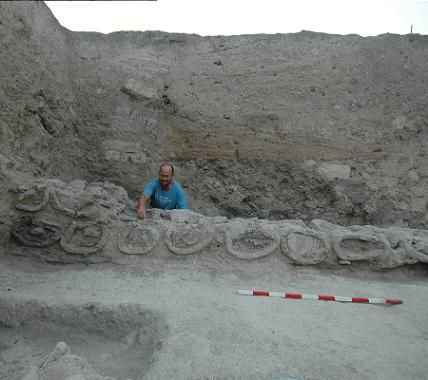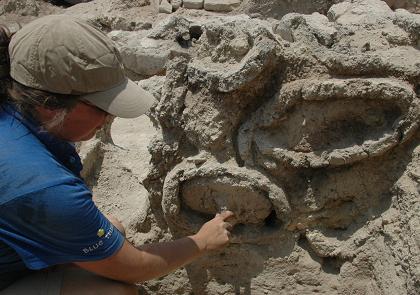Archaeological evidence of the biblical description of Israel as a 'land of milk and honey' was discovered by researchers from the Institute of Archeology of the Hebrew University
Archaeological evidence of the biblical description of Israel as a 'land of milk and honey' was discovered by researchers from the Institute of Archeology of the Hebrew University.
Prof. Amichai Mazar from the Institute of Archeology at the Hebrew University reveals that for the first time a beehive from the biblical period was discovered in archaeological excavations conducted this summer by his management at the Tel Rehov site in the Beit Shean Valley. "This is the oldest apiary known to this day," says Prof. Mazar. "It dates from the tenth to the beginning of the ninth century BC".
Tel Rehov is the site of one of the most important cities during the time of the kings of Israel, although it is not mentioned in the Bible. The beehive was discovered in the heart of a built-up area in an area excavated since 1997 under the direction of Dr. Nava Panitz-Cohen, a researcher at the Hebrew University. Three rows of hives were discovered with more than thirty hives. According to the findings of the excavations, it is estimated that there were about a hundred beehives in the excavated section. Each column had at least three floors of hives. Each beehive is built as a cylinder, made of clay and dried straw, which is eighty cm long and forty cm in diameter. At one end of the cylinder there is a wall with a tiny opening that allowed bees to enter and exit the hive. At the other end is a mud cover through which honeycombs have fallen. Beekeepers and researchers who visited the site estimated that from the excavated area it was possible to produce about half a ton of honey per year.
Prof. Mazar emphasizes the uniqueness of this find since until now no beehives have been discovered at any site in the ancient Near East and beekeeping on an industrial and organized scale like the one discovered at Tel Rehov was not known at all. From the Hellenistic and Roman periods, pottery that was used for beekeeping is known, but no beehives have been discovered.
Artistic depictions of beehives are known from Pharaonic Egypt. The shape of the Egyptian beehives is similar to those discovered in Tel Rehov. Horizontal cylindrical beehives made of clay, similar to those discovered at Tel Rehov, are known from many contemporary traditional cultures and examples of this are found in Arab villages in Israel and the Middle East countries. The products of the apiary had various uses: the honey was used for food and it was known to be important in medicine and worship. Bees' dung was used in the metal industry, in tanneries and medicine as well as as a writing material after being spread on wooden boards.
Other researchers are involved in the study of the beehives. Dr. Guy Bloch from the Institute of Life Sciences at the Hebrew University is investigating the biological find from the beehives and has already discovered bee parts in the remains of honeycombs removed from the beehives; Dr. Debori Namdar from the Weizmann Institute of Science was able to identify molecules of beeswax on the walls of the hives; Prof. Mina Evron from the University of Haifa studies the flower pollen (pollen) found in beehives.
The dating of the beehive was done with the help of measuring the carbon 14 isotope on wheat kernels found near the beehives. In the laboratories of the University of Groningen in the Netherlands, the wheat kernels were dated to the period between the middle of the tenth century BC and the beginning of the ninth century BC. This period corresponds to the days of King Solomon and the first kings of the Kingdom of Israel after the division of the kingdom. The city of Rehov is indeed mentioned in an Egyptian inscription from the time of Pharaoh Shishak, who according to the Bible was a contemporary of Solomon and invaded the Land of Israel after the king's death.
Of particular interest is an inscription on a clay jug found in the apiary's grounds, on which is written the name "Lanmash". This name was discovered in two additional inscriptions, one in Tel Rehov itself and another in Tel Amal in the area of the Garden of Three (Sahnah). The name Nimshi (in full spelling) is known in the Bible as the name of Jehu's grandfather, the founder of the dynasty that replaced the Amri dynasty (XNUMX Kings XNUMX:XNUMX, XNUMX). It is speculated that the finding of three inscriptions bearing this name in the same area and at the same time indicates that the Yehu family came from the Beit Shan Valley area and even from the large city that existed at that time in Tel Rehov. It is possible that the unique beehive discovered in Tel Rehov belonged to this family.
The term honey appears in the Bible fifty-five times - sixteen of them in the image of the land as 'a land flowing with milk and honey'. It is commonly thought that the term refers to honey produced from fruits such as dates and figs. Bee honey is specifically mentioned in the Bible only twice, in the context of wild bees: in the story of Samson who stole bee honey from the lion's carcass in the Shork River (Judges XNUMX:XNUMX-XNUMX) and in the story of Jonathan son of Saul dipping his hand in the honey forest during the war of Michmash (XNUMX Samuel XNUMX) XNUMX:XNUMX).
While the Bible does not tell us anything about beekeeping in the Land of Israel, the discovery of the apiary in Tel Rehov indicates that the branch of beekeeping and the production of honey and bee dung was already developed in the days of the First Temple. It is therefore possible that the term honey in the Bible does refer to bee honey.
Near the beehives, unusual cult objects were found, including a four-horned altar decorated with figures of naked fertility goddesses and a magnificent pottery cup. This is probably evidence of ritual ceremonies that were related to the production of honey and honey, as was customary in the production of various other materials in the ancient world. The prohibition of smoking honey on altars mentioned in the Book of Leviticus (Leviticus XNUMX:XNUMX) could hint at the existence of such a practice in Israel.
The excavations at Tel Rehov are being done with the support of Mr. John Kemp from Minnesota in the USA and are attended by archeology students from the Hebrew University and many volunteers.

General view of a column of beehives in Tel Rehov, 9th-10th century BC (photo 1611)

An opening for radiating chalot in one of the beehives in Tel Rehov (photo 1508). Photographs: Amichai Mazar, Institute of Archaeology, Hebrew University

4 תגובות
My mother is one of the archaeologists who dug there and found the beehives - Dr. Nava Panitz-Cohen.
An interesting phenomenon is that in the Iron Age 2a all kinds of technological innovations emerge that are not only unique in the Land of Israel but in the entire Ancient Near East, such as the beehives in this article, whose parallels are unknown in the entire region. And like for example the "smithy" the iron industry that was discovered in Tel Beit Shemesh and according to Dr. Bonimowitz and Walderman the first of its kind (a workshop for the production of iron tools) in the ancient Near East during the Iron Age 2a (950-800 BC) and which Shumar is probably the first of its kind in the world!!!
It's amazing when you think about it that a modern beekeeper of his own age, if he met the beekeeper from those days, could work with him as equals at the most professional level.